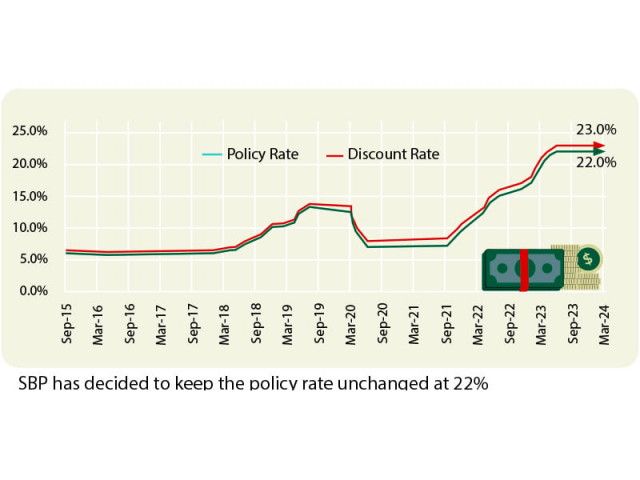SBP maintains key rate at record 22%
Cites caution amid ongoing IMF talks and inflation concerns

Pakistan’s central bank has left its key policy rate unchanged at a record high of 22% for the fifth consecutive time in the past nine months, taking a cautious approach against a likely uptick in inflation readings, which have started cooling down but remain elevated amid ongoing talks with the International Monetary Fund (IMF).
In its latest monetary policy statement (MPS) for the next six weeks, the State Bank of Pakistan (SBP) said that in approaching Monday’s decision, the monetary policy committee (MPC) noted that inflation has begun to decline noticeably from January 2024, in line with earlier expectations.
“The Committee, however, observed that despite the sharp deceleration in February, the level of inflation remains high, and its outlook is susceptible to risks amidst elevated inflation expectations.”
The MPC noted that headline inflation registered a broad-based and considerable year-on-year decline from 28.3% in January to 23.1% in February.
The recent uptrend in international petroleum oil prices poses a threat to increase the country’s imports and add imported inflation to the domestic economy in the wake of the ongoing tense situation in the Red Sea.
More importantly, the government’s assurance to the IMF in the ongoing talks for the next tranche of $1.1 billion and for securing a new – longer and larger programme – that it would further increase electricity prices soon. Besides, fiscal measures that may push prices up pose a risk to the near and medium-term inflation outlook.
“Cognisant of these risks, the Committee assessed that it is prudent to continue with the current monetary policy stance at this stage,” the SBP said in its policy statement.
The SBP noted that while energy inflation also decelerated on a year-on-year basis in February, “the adjustments in administered energy prices have continued to contribute to inflation directly and indirectly. This has implications for the needed sustained decline in inflation expectations of both consumers and businesses.”
However, the “improvement in inflation broadly reflects the combined impact of contractionary monetary policy, fiscal consolidation, better food supplies, moderating global commodity prices, and a favourable base effect.”
Financial experts and key investors had stood sharply divided over whether the central bank would cut the rate or maintain it on Monday, believing inflation has decelerated and made the real interest rate positive on a forward-looking basis and would turn positive on the spot level as well this month (March 2024).
In January, the central bank revised up its projection for average monthly inflation reading to 23-25% for the ongoing fiscal year 2023-24 due to an increase in energy prices by the government compared to the original (July 2023’s) expectations for 20-22% for the year.
Read: SBP purchases $2b from market
It did not repeat its estimate for the full-year FY24 inflation expectation in the latest statement on Monday.
It, however, urged a cautious approach and continuity of the current monetary stance to bring inflation down to the target range of 5–7% by September 2025.
Earlier, the central bank revised up its key policy rate cumulatively by 15 percentage points from September 2021 to June 2023, raising it to a record high of 22%.
Key developments
The central bank’s committee noted a few key developments since its last meeting held in late January 2024 that have implications for the macroeconomic outlook.
First, the latest data continues to depict a moderate pick-up in economic activity, led by a rebound in agriculture output.
Second, the external current account balance is turning out better than anticipated and has helped maintain foreign exchange (FX) buffers despite weak financial inflows.
Third, while inflation expectations of businesses have shown a steady increase since December, those for consumers have also inched up in March.
Lastly, on the global front, while the broader trend in commodity prices remains benign, oil prices have increased; partly reflecting the continued tense situation in the Red Sea. Moreover, amidst uncertainty regarding the inflation outlook, key central banks in both advanced and emerging economies have continued to maintain a cautious monetary policy stance in recent meetings, SBP said.
Economic outlook stays stable
The central bank reiterated that incoming data supports the MPC’s earlier expectation of a moderate recovery in economic activity in FY24, with real GDP growth expected to remain in the range of 2–3% compared to a contraction of 0.3% in the previous fiscal year.
The agriculture sector remains the key driver. After a strong performance of Kharif crops (especially cotton and rice), prospects for the wheat crop also look promising due to an increase in area under cultivation, better input conditions, and higher output prices.
“Denser vegetation of the wheat crop, as captured by satellite images, also supports this assessment,” the central bank said.
In the industrial sector, despite a slight decline of 0.5% during July-January, large-scale manufacturing is expected to recover in the coming months due to improved capacity utilisation and employment conditions and a favourable base effect.
Furthermore, the knock-on impact of commodity producing sectors and other leading indicators point towards gradual recovery in the services sector, it said.
Published in The Express Tribune, March 19th, 2024.
Like Business on Facebook, follow @TribuneBiz on Twitter to stay informed and join in the conversation.


















COMMENTS
Comments are moderated and generally will be posted if they are on-topic and not abusive.
For more information, please see our Comments FAQ